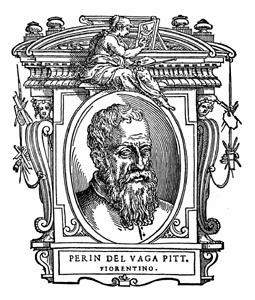Perino del Vaga facts for kids

Perino del Vaga (born Piero Bonaccorsi) was an Italian artist. He was a painter and a draughtsman. He lived from 1501 to 1547. Perino was an important artist during the Late Renaissance and Mannerism periods.
Contents
Early Life and Training
Perino was born near Florence, Italy. His father lost all his money gambling. He then became a soldier. Perino's mother died when he was very young. His father's second wife took care of him.
Perino first started working for a druggist. But he soon began to study art. He learned from a painter named Andrea de' Ceri. When he was eleven, he studied with Ridolfo Ghirlandaio. Perino was one of Ghirlandaio's best students.
Moving to Rome
Another painter, Vaga from Toscanella, helped Perino move to Rome. When Perino arrived in Rome, he was very poor. He had to do simple art jobs to make money.
Soon, he got to work with the famous artist Raphael. Perino helped Raphael with projects in the Vatican. He assisted Giovanni da Udine with decorations. These included stucco and arabesque designs. They worked in the Loggie Vaticane. Perino also painted small, detailed Bible scenes. These are sometimes called Raphael's Bible. Raphael himself created the designs for these works.
Working with Raphael
Some of Perino's works from this time include Abraham and Isaac. He also painted Jacob wrestling with the Angel. Other scenes were Joseph and his Brothers and the Hebrews crossing the Jordan. He painted the Fall and Capture of Jericho. He also did Joshua commanding Sun to stand still. Other works were the Birth of Christ, Baptism, and the Last Supper. Some of these paintings looked like bronze. Others were in full color.
Perino also painted figures of planets. He did this in a large hall in the Appartamenti Borgia. He used Raphael's drawings for these. Perino quickly became Raphael's main helper. Only Giulio Romano was considered more important. Perino was always very loyal to Raphael.
After Raphael died in 1520, times became hard for Perino. A plague also hit in 1523. Perino went back to Florence. There, he became friends with Rosso Fiorentino. He created a great design called 10,000 Martyrs. This artwork is now lost.
Work in Genoa
In 1527, a rich man named Andrea Doria invited Perino to Genoa. Doria wanted him to decorate his newly rebuilt home. This home was the Villa del Principe. Perino started this work in 1529. He used a style similar to Giulio Romano's work. Giulio Romano had decorated the Palazzo Te in Mantua.
The finished palace had many frescoes. These paintings showed stories from myths and history. They also had beautiful arabesque designs. These were fancy and graceful patterns. There were also sculpted details made of stucco. Some main works included the War between the Gods and Giants. He also painted Horatius Cocles defending the Bridge. Another was the Fortitude of Mutius Scaevola. The most important work was the Shipwreck of Aeneas. Sadly, this painting no longer exists.
Perino also created many altarpieces. These are artworks for church altars. He also made designs for tapestries. He quickly started a new art school in Genoa. This school was like the Roman style. He visited Pisa twice. He began some paintings in the cathedral there.
Later Work in Rome
A year later, Perino returned to Rome. He painted frescoes in the Pucci Chapel. This chapel is in the Trinità dei Monti church. Pope Paul III gave him a regular salary. Perino also touched up many of Raphael's artworks.
He painted decorations for the Pauline Chapel. He also worked in other halls of Castel Sant'Angelo. He painted some frescoes in the church of San Marcello. He did a monochrome painting in the Stanza della Segnatura in the Vatican. He also made a cartoon (a large drawing for a fresco) for the Sistine Chapel.
Perino was working on decorating the Sala Reale. Pope Paul III had started this project. Perino died on October 19, 1547, in Rome. He is buried in the Pantheon. His student Pellegrino Tibaldi finished his work in the Castel Sant'Angelo.
Artistic Style and Influence
Perino del Vaga's art was known for being lively and elegant. His paintings helped connect the Roman style of Raphael with the early Mannerism in Florence. He combined the styles of Raphael and Andrea del Sarto. Many of his artworks were copied as engravings. This happened even when he was alive.
Several artists worked as his main assistants. These included Daniele da Volterra and Girolamo Siciolante da Sermoneta. Others were Luzio Romano and Marcello Venusti.
See also
 In Spanish: Perin del Vaga para niños
In Spanish: Perin del Vaga para niños


